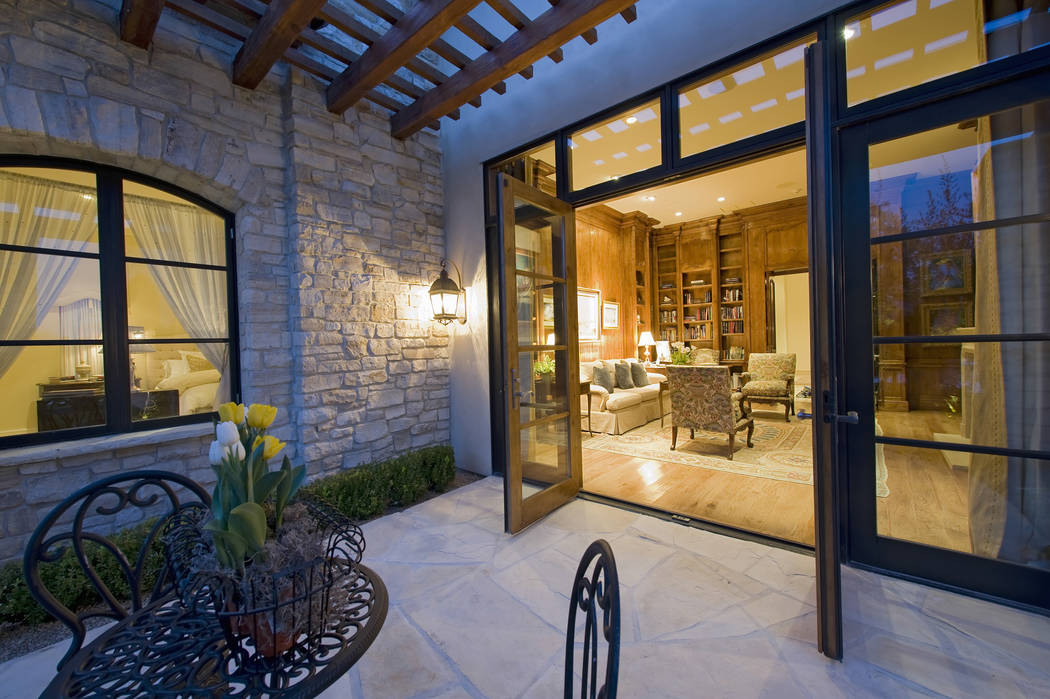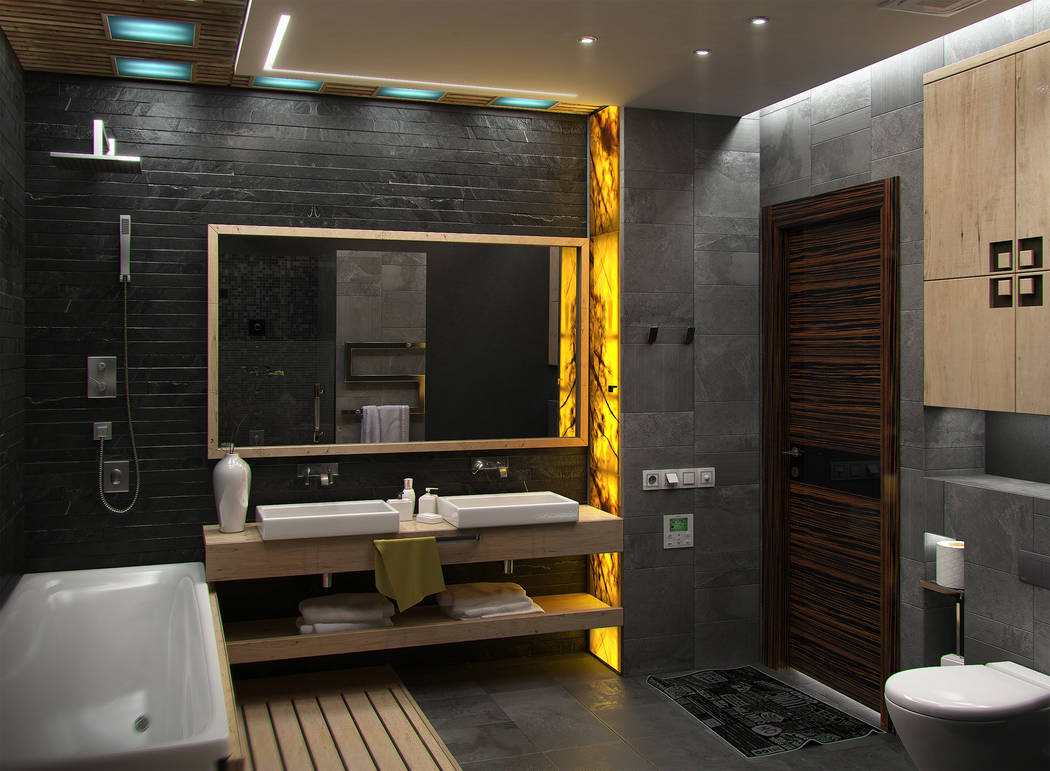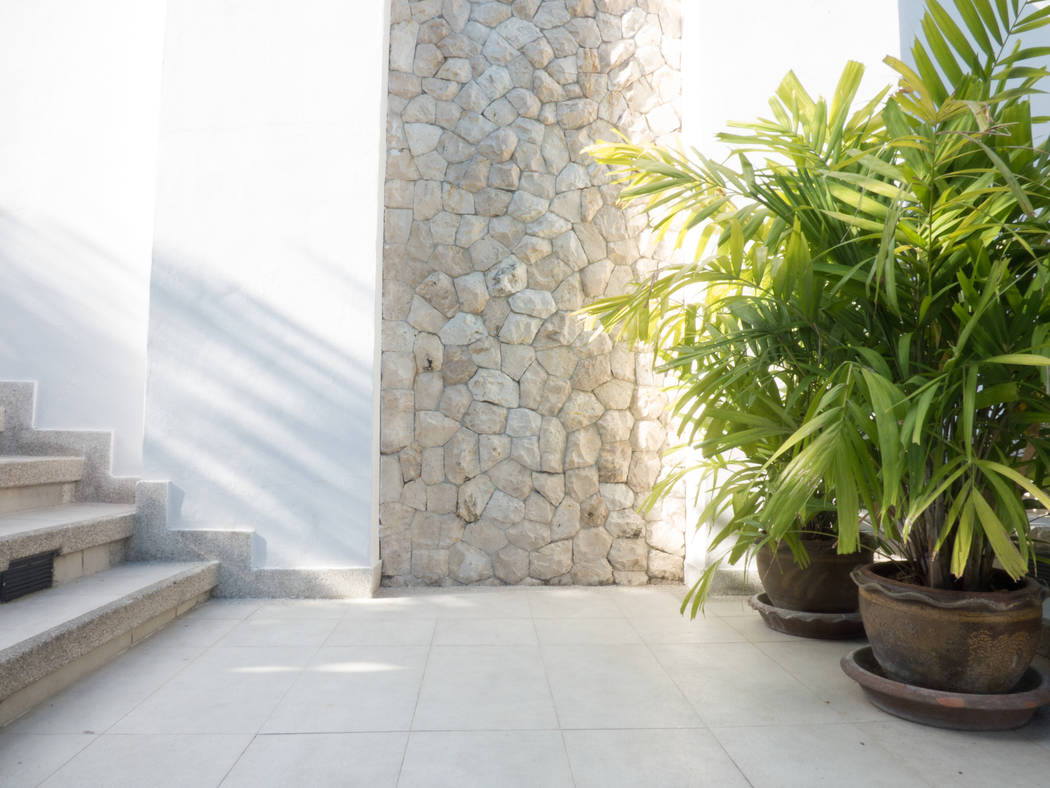Make your home rock
Dominated by stucco exteriors and textured interior walls, the valley’s long-held Mediterranean-inspired architecture often begs for a splash of something different. So for years, interior designers have welcomed bold-colored accent walls alongside their neutral sand and gray hues, and architects have implemented pop-outs to break up the monotony of long stucco runs on the outside of homes.
Using stone is a time-tested aesthetic popularized by legendary architect Frank Lloyd Wright that is still used today by valley home designers and architects. Wright’s Fallingwater home in Pennsylvania is a historic monument and one prominent example of the architect’s affinity for stacking stone along the interior and exterior walls, merging the indoors and outdoors.
“With stone, you get that mid (century) mod feel, and Frank Lloyd Wright was certainly someone who embraced that,” said Julie Porter, a Las Vegas interior designer and owner of Julie Porter Associates. “Stone walls add to that contemporary, cool feel and let you bring the outdoors into the home.”
“I have always loved using stone inside homes. Stone creates a beautiful contrast when placed next to soft fabrics in furniture,” said Heather Hess, another local interior designer.
Here’s a look at some of the ways the tried-and-true uses for stone in home design has changed and also stayed the same through the years.
Pop-out remedy
It’s a minimal, subtle touch, but one of the most common ways homeowners break up long runs of stucco on exteriors is to request pop-outs of a different color around windows or on corners of homes. Today, more and more opt for stone in these areas instead.
“For a long time, people really liked that pop-out color, but with stone, it’s more permanent. And think about it, you don’t ever have to paint again,” said Anthony Temblador, owner of Trident Tile and Stone in Las Vegas.
Some homeowners are opting for bolder statements on their exteriors, adding stacked stone on the entire bottom half of a wall. Some will even cover an entire wall on the front of their home. Wrapping columns and archways is still popular on exteriors as well, both Temblador and Porter said.
Floor-to-ceiling trend
Stone interior accent walls have also grown in popularity, both Porter and Temblador said. But where in the past covering a section of a wall was common, now homeowners ask for entire walls to be covered.
“Now, it’s more of that long wall. It could be 15 feet long or more. There may be a TV on it or not. Usually, it’s a wall they see all the time. … They want the whole wall, and they want it floor to ceiling,” Temblador said.
Ledger stone products, available in a lighter veneer or in actual stone, are popular for large accent walls. Many are manufactured in 6-by-18-inch or 24-inch sizes and come in palettes. Fireplace requests, another popular area in the home for stone, now also command more surface area to be covered.
“In the old days, you covered fireplaces 12 to 18 inches around and that was it,” Porter recalled. “Now you’re doing the entire wall, or maybe it’s a foot on each side of the fireplace, but you’re going floor to ceiling.”
Beyond accent walls, fireplaces
Kitchen and bathroom counters have long been among the most popular areas of the home for stone, and they comprise the bulk of the stone requests for both Porter and Temblador. Granite, slate and quartz are the most requested, Porter says, but she says quartz, even though it’s man-made, is becoming more and more the runaway favorite.
“It’s man-made, but it’s indestructible and maintenance free, and that’s what people love about it,” she added.
In bathrooms, Porter has also had requests for entire stone accent walls, and large stacked stone or ledger stone sections are also popular on walls behind bathroom sinks.
One of her favorite uses for stone comes with water features. In more contemporary custom homes, homeowners are getting away from traditional fountains, and instead looking to create water features that run down the length of a wall. These features are perfect for stone, Porter says, and are a great opportunity to introduce a touch of the outdoors into an interior.
“In our desert environment, it also keeps the humidity in the homes, and with the way it recirculates, it’s more of a quiet flow instead of the bubbling sound of a fountain,” the designer explained.
Before you buy
If you do think stone would be the perfect touch for your home, here are some important factors to keep in mind.
Ask about sealing the stone. Unless the stone is exposed to harsh elements like water or sun, for interiors, you can expect the seal put on during installation to last a lifetime, Temblador said. But for exteriors, you might need to reseal periodically.
Interior heights should be a contractor vetting point. When vetting contractors, if you want stone on, say, an accent wall or fireplace, ask about the contractor’s process. Anything above 6 feet will need to be secured properly with metal lathe and cement board, otherwise, it could fall down, Temblador said.
“There are those contractors who learned to stack stone but don’t know these details,” he noted. “If you’re just putting stone around the fireplace, that’s fine, but if it’s anything that’s floor to ceiling, you have to make sure they know what they’re doing.”
Time and cost considerations. Stone work will take longer than a regular exterior or interior textured or stucco wall, Porter said. If you’re incorporating it into a new build, expect that wall to be about four to five times the cost of a standard interior or exterior wall, she added. The work requires a craftsman, and if there’s a lot of stone on the job, chances are you’ll need a structural engineer involved too.
“The labor will cost more because you have to get a contractor that knows what he’s doing and has the equipment,” Porter said. “There’s a lot more involved, and that’s what drives up the cost.”

























